 |
| November 28, 2017 | Volume 13 Issue 44 |
Mechanical News & Products
Designfax weekly eMagazine
Archives
Partners
Manufacturing Center
Product Spotlight
Modern Applications News
Metalworking Ideas For
Today's Job Shops
Tooling and Production
Strategies for large
metalworking plants
How ball spline coatings enhance performance and extend component life
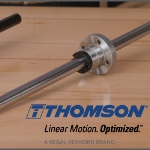 According to Thomson, "Precision ball splines have gained popularity as an ideal choice for applications that require low-friction linear and rotary motion. These components, which utilize a single splined shaft, enable complex movements in multiple directions." But how do you keep these ball splines performing at their peak for longer? Coatings can do the trick, and Thomson has three of them: black oxide, hard chrome plating, and nickel plating. Learn more about these coatings and which one makes the most sense for your precision ball spline solution.
According to Thomson, "Precision ball splines have gained popularity as an ideal choice for applications that require low-friction linear and rotary motion. These components, which utilize a single splined shaft, enable complex movements in multiple directions." But how do you keep these ball splines performing at their peak for longer? Coatings can do the trick, and Thomson has three of them: black oxide, hard chrome plating, and nickel plating. Learn more about these coatings and which one makes the most sense for your precision ball spline solution.
View the video.
Key factors for ball screw applications
 Learn the six key factors that should be considered when specifying ball screw assemblies in motion control applications. PCB Linear gathered a panel of experts in the field of linear motion to concentrate on this important topic -- particularly when it comes to the company's new miniature ball screw product line. Learn about precision and accuracy, orientation, speed and acceleration, duty cycle, linear motion travel, and load capacity. Podcast available too.
Learn the six key factors that should be considered when specifying ball screw assemblies in motion control applications. PCB Linear gathered a panel of experts in the field of linear motion to concentrate on this important topic -- particularly when it comes to the company's new miniature ball screw product line. Learn about precision and accuracy, orientation, speed and acceleration, duty cycle, linear motion travel, and load capacity. Podcast available too.
Read the PCB Linear blog.
3D printer uses pellet extrusion system instead of filament
 The latest addition to 3D Systems' industry-leading portfolio of EXT Titan Pellet systems is the EXT 800 Titan Pellet. With a build volume of 800 x 600 x 800 mm, this thermoplastics 3D printer harnesses the speed, reliability, and efficiency of the company's large-format pellet systems in a more compact unit with lower upfront investment. Use this machine to fabricate more modestly sized functional prototypes, tooling, fixtures, sand casting patterns, thermoforming molds, and end-use parts. Markedly faster than competing FFF and FDM printers, and up to 10X reduced material costs compared to filaments.
The latest addition to 3D Systems' industry-leading portfolio of EXT Titan Pellet systems is the EXT 800 Titan Pellet. With a build volume of 800 x 600 x 800 mm, this thermoplastics 3D printer harnesses the speed, reliability, and efficiency of the company's large-format pellet systems in a more compact unit with lower upfront investment. Use this machine to fabricate more modestly sized functional prototypes, tooling, fixtures, sand casting patterns, thermoforming molds, and end-use parts. Markedly faster than competing FFF and FDM printers, and up to 10X reduced material costs compared to filaments.
Learn more.
Test your knowledge: High-temp adhesives
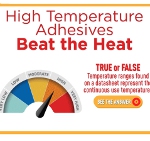 Put your knowledge to the test by trying to answer these key questions on how to choose the right high-temperature-resistant adhesive. The technical experts from Master Bond cover critical information necessary for the selection process, including questions on glass transition temperature and service temperature range. Some of the answers may surprise even the savviest of engineers.
Put your knowledge to the test by trying to answer these key questions on how to choose the right high-temperature-resistant adhesive. The technical experts from Master Bond cover critical information necessary for the selection process, including questions on glass transition temperature and service temperature range. Some of the answers may surprise even the savviest of engineers.
Take the quiz.
World's first current-carrying fastening technology
 PEM® eConnect™ current-carrying pins from Penn-Engineering provide superior electrical connections in applications that demand high performance from internal components, such as automotive electronics. This first-to-market tech provides repeatable, consistent electrical joints and superior installation unmatched by traditional fastening methods. Features include quick and secure automated installation, no hot spots or poor conductivity, and captivation options that include self-clinching and broaching styles.
PEM® eConnect™ current-carrying pins from Penn-Engineering provide superior electrical connections in applications that demand high performance from internal components, such as automotive electronics. This first-to-market tech provides repeatable, consistent electrical joints and superior installation unmatched by traditional fastening methods. Features include quick and secure automated installation, no hot spots or poor conductivity, and captivation options that include self-clinching and broaching styles.
Learn more about eConnect pins.
New flat quarter-turn clamping fastener
 IMAO Fixtureworks has expanded its One-Touch Fastener lineup to include a new quarter-turn clamping fastener that features an innovative flat design and is ideal for clamping in limited spaces. The QCFC flat quarter-turn fastener features a recessed body that protrudes only 2 mm from the mounted surface, a knob that rests flush inside the body, visible ON and OFF markings for safety, and an audible click when fully turned to clamped or unclamped position.
IMAO Fixtureworks has expanded its One-Touch Fastener lineup to include a new quarter-turn clamping fastener that features an innovative flat design and is ideal for clamping in limited spaces. The QCFC flat quarter-turn fastener features a recessed body that protrudes only 2 mm from the mounted surface, a knob that rests flush inside the body, visible ON and OFF markings for safety, and an audible click when fully turned to clamped or unclamped position.
Learn more.
Bellows and disc couplings with higher torque capacity
 Ruland Manufacturing now offers bellows and double disc couplings with bore sizes up to 1-3/4 in. or 45 mm for use in systems with torque up to 1,400 in.-lb (158 Nm). High-torque applications in precision semiconductor, solar, conveyor, and factory automation applications often use these shaft sizes. Ruland disc and bellows couplings accommodate all forms of misalignment, are zero-backlash, and have a balanced design for reduced vibration at speeds up to 10,000 rpm.
Ruland Manufacturing now offers bellows and double disc couplings with bore sizes up to 1-3/4 in. or 45 mm for use in systems with torque up to 1,400 in.-lb (158 Nm). High-torque applications in precision semiconductor, solar, conveyor, and factory automation applications often use these shaft sizes. Ruland disc and bellows couplings accommodate all forms of misalignment, are zero-backlash, and have a balanced design for reduced vibration at speeds up to 10,000 rpm.
Learn more.
Simplify your designs with slewing ring bearings
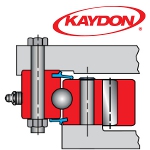 According to Kaydon Bearings, "A slewing ring bearing has rolling elements designed to create a reactive moment within the bearing's dimensions envelope to oppose applied (overturning) moment load," so you can use one bearing instead of two, reducing the height requirements, and even improve performance. Slewing ring bearings can also simplify a drive system by utilizing gear teeth on the inner or outer race. Learn all about slewing ring bearings in this informative article.
According to Kaydon Bearings, "A slewing ring bearing has rolling elements designed to create a reactive moment within the bearing's dimensions envelope to oppose applied (overturning) moment load," so you can use one bearing instead of two, reducing the height requirements, and even improve performance. Slewing ring bearings can also simplify a drive system by utilizing gear teeth on the inner or outer race. Learn all about slewing ring bearings in this informative article.
Read the Kaydon whitepaper.
Jet valve for ultra-small dispensing
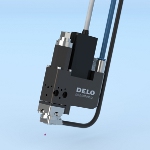 DELO's DELO-DOT PN5 LV pneumatic jet valve is designed for micro-dispensing low-viscosity adhesives and other media in miniaturized applications. Thanks to its compact design, it also requires very little space to install in production systems. Interchangeable nozzles with different diameters and a flexible, adjustable plunger stroke ensure precise and reliable applications at different droplet sizes. Volumes of as low as 1 nl can be achieved, which corresponds to droplet diameters of 250 µm or less.
DELO's DELO-DOT PN5 LV pneumatic jet valve is designed for micro-dispensing low-viscosity adhesives and other media in miniaturized applications. Thanks to its compact design, it also requires very little space to install in production systems. Interchangeable nozzles with different diameters and a flexible, adjustable plunger stroke ensure precise and reliable applications at different droplet sizes. Volumes of as low as 1 nl can be achieved, which corresponds to droplet diameters of 250 µm or less.
Learn more.
Stainless steel constant-torque flush-mount hinge
 Southco has introduced a flush-mount version of its popular and durable E6 constant-torque hinge. Its low-profile, corrosion-resistant package makes it an ideal solution for maximizing security, longevity, and aesthetics. It offers high torque for demanding applications while maintaining its low profile. Lots of uses.
Southco has introduced a flush-mount version of its popular and durable E6 constant-torque hinge. Its low-profile, corrosion-resistant package makes it an ideal solution for maximizing security, longevity, and aesthetics. It offers high torque for demanding applications while maintaining its low profile. Lots of uses.
Learn more.
Claw vacuum pump for industrial applications
 Vacuum expert Leybold has added a new model to its proven CLAWVAC dry claw vacuum pump series: the CLAWVAC CP B. This innovative, rough vacuum pump, designed for robust processes including food processing, material handling, and environmental industries, is powerful, energy efficient, and easy to clean. The intuitive handling of this unit is mainly due to its functional design, which features a pair of claws that rotate in the cylinder with no contact or wear. Its separate gearbox prevents oil contamination. The design ensures short downtimes and long service intervals: 20,000 hr between oil changes and up to 48,000 hr between general overhauls.
Vacuum expert Leybold has added a new model to its proven CLAWVAC dry claw vacuum pump series: the CLAWVAC CP B. This innovative, rough vacuum pump, designed for robust processes including food processing, material handling, and environmental industries, is powerful, energy efficient, and easy to clean. The intuitive handling of this unit is mainly due to its functional design, which features a pair of claws that rotate in the cylinder with no contact or wear. Its separate gearbox prevents oil contamination. The design ensures short downtimes and long service intervals: 20,000 hr between oil changes and up to 48,000 hr between general overhauls.
Learn more.
DualVee linear guides and tracks used in warehousing
 See how Bishop-Wisecarver's DualVee® motion tech can add huge benefits to warehousing operations. This video highlights two applications: a manual storage and retrieval system and an automated storage and retrieval system of long aerospace-grade carbon fiber in sub-zero temps. Patented DualVee guides and tracks keep operations running smoothly.
See how Bishop-Wisecarver's DualVee® motion tech can add huge benefits to warehousing operations. This video highlights two applications: a manual storage and retrieval system and an automated storage and retrieval system of long aerospace-grade carbon fiber in sub-zero temps. Patented DualVee guides and tracks keep operations running smoothly.
View the video.
Build-to-order knobs and hand hardware
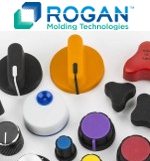 Rogan Corp.'s innovative use of two-shot plastic injection and insert molding has been providing customers with high-quality plastic clamping knobs, levers, and control knobs for almost 90 years. Rogan offers concurrent engineering, product design, and assistance in material selection to ensure customer satisfaction for standard or customized parts, with a focus on cost optimization and on-time delivery. Custom colors, markings, decorative inlays, or engineered materials to meet special requirements, such as adding extra strength or utilizing flame-retardant material, are all offered.
Rogan Corp.'s innovative use of two-shot plastic injection and insert molding has been providing customers with high-quality plastic clamping knobs, levers, and control knobs for almost 90 years. Rogan offers concurrent engineering, product design, and assistance in material selection to ensure customer satisfaction for standard or customized parts, with a focus on cost optimization and on-time delivery. Custom colors, markings, decorative inlays, or engineered materials to meet special requirements, such as adding extra strength or utilizing flame-retardant material, are all offered.
Learn more.
Slewing ring bearing made of wood and plastic
 The PRT-02-30-WPC slewing ring bearing is another step forward by igus toward integrating renewable raw materials into industrial production. Made of 50% wood and 50% high-performance plastics, the cost-effective and lubrication-free slewing ring bearing balances strength and durability with a proven low CO2 footprint. The materials incorporate solid lubricants, making the new slewing ring bearing smooth running and maintenance-free.
The PRT-02-30-WPC slewing ring bearing is another step forward by igus toward integrating renewable raw materials into industrial production. Made of 50% wood and 50% high-performance plastics, the cost-effective and lubrication-free slewing ring bearing balances strength and durability with a proven low CO2 footprint. The materials incorporate solid lubricants, making the new slewing ring bearing smooth running and maintenance-free.
Learn more.
Flex Locators for quick fixture changeover
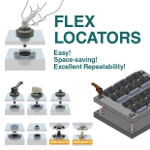 Flex Locators from Fixtureworks are designed for quick changeover of small and large fixtures, automation components, and more. They are ideal for applications that require frequent disassembly, providing excellent repeatability for locating and clamping in a single operation. Manual and pneumatic versions are available. Just turn the handle, knob, or screw!
Flex Locators from Fixtureworks are designed for quick changeover of small and large fixtures, automation components, and more. They are ideal for applications that require frequent disassembly, providing excellent repeatability for locating and clamping in a single operation. Manual and pneumatic versions are available. Just turn the handle, knob, or screw!
View the video.
How to float your coffee creamer: Study explains how droplets can 'levitate' on liquid surfaces
By Jennifer Chu, MIT
A drop or two of cold cream in hot coffee can go a long way toward improving one's morning. But what if the two liquids didn't mix?
MIT scientists have now explained why, under certain conditions, a droplet of liquid should not coalesce with the liquid surface below. If the droplet is very cold, and the bath sufficiently hot, then the droplet should "levitate" on the bath's surface, as a result of the flows induced by the temperature difference.
The team's results, published in the Journal of Fluid Mechanics, offer a detailed, mathematical understanding of drop coalescence, which can be observed in everday phenomena, from milk poured in coffee to raindrops skittering across puddles, and sprays created in surf zones.
The results may help researchers understand how biological or chemical substances are spread by rain or other sprays in nature. They could also serve as a guide for droplet-based designs, such as in microfluidic chips, in which droplets carrying various reagents can be designed to mix only in certain locations in a chip, at certain temperatures. With this new understanding, researchers could also engineer droplets to act as mechanical ball bearings in zero-gravity environments.
VIDEO: This video shows that a temperature difference between a droplet and a bath can help levitate droplets without any direct contact.
"Based on our new theory, engineers can determine what is the initial critical temperature difference they need to maintain two drops separately, and what is the maximum weight that a bearing constructed from these levitating drops would be able to sustain," says Michela Geri, a graduate student in MIT's Department of Mechanical Engineering and the study's lead author. "If you have a fundamental understanding, you can start designing things the way you want them to work."
Geri's co-authors are Bavand Keshavarz, a lecturer in mechanical engineering, John Bush, professor of applied mathematics in MIT's Department of Mathematics, and Gareth McKinley, the School of Engineering Professor of Teaching Innovation.
An uplifting experiment
The team's results grew out of a question that Bush posed in his graduate course 18.357 (Interfacial Phenomena): Why should a temperature difference play a role in a droplet's coalescence, or mixing?
Geri, who was taking the course at the time, took on the challenge, first by carrying out a series of experiments in McKinley's lab.
She built a small box, about the size of an espresso cup, with acrylic walls and a metal floor, which she placed on a hot/cold plate. She filled the cube with a bath of silicone oil, and just above the surface of the bath she set a syringe through which she pumped droplets of silicone oil of the same viscosity. In each series of experiments, she set the temperature of the hot/cold plate, and measured the temperatures of the oil pumped through the syringe and at the surface of the bath.
Geri used a high-speed camera to record each droplet, at 2,000 frames per second, from the time it was released from the syringe to the time at which it mixed thoroughly with the bath. She performed this experiment using silicone oils with a range of viscosities, from water-like to 500 times thicker.
She found that droplets appeared to levitate on a bath's surface as the temperature gradient between the two fluids increased. She was able to levitate a droplet, delaying its coalescence, by as long as 10 seconds, by maintaining a temperature difference of up to 30 deg C, or 86 deg F, comparable to the difference between a drop of cold milk on a bath of hot black coffee.
Geri plotted the data and observed that the droplet's residence time on the bath's surface seemed to depend on the initial temperature difference between the two fluids, raised to the power of two-thirds. She also noticed that there exists a critical temperature difference at which a droplet of a given viscosity will not mix but instead levitate on a liquid surface.
"We saw this relationship clearly in the lab and then tried to develop a theory in hopes of rationalizing that dependence," Geri says.
A cushion's character
The team first looked to characterize the layer of air separating the droplet from the bath. The researchers hypothesized that a temperature difference between the two fluids may influence this air cushion, which may in turn act to keep a droplet afloat.
To investigate this idea mathematically, the researchers performed a calculation, referred to in fluid mechanics as a lubrication analysis, in which they appropriately simplified the complex equations describing fluid motion, to describe the flow of air between the droplet and the bath.
Through these equations, they found that temperature differences between the fluid drop and the fluid bath create convection, or circulating currents in the intervening layer of air. The greater the temperature difference, the stronger the air currents, and the greater the pressure that pushes against the droplet's weight, preventing it from sinking and making contact with the bath.
"We found the force coming from the droplet's weight and the force coming from the recirculation of the air layer will balance at a point, and to get that balance, you need a minimum, or critical temperature difference, in order for the droplet to levitate," Geri says.
Inside a single drop
Next, the team looked for a mathematical explanation for why they observed the 2:3 relationship between the amount of time a droplet levitates on a liquid surface and the initial temperature difference between the two fluids.
"For that, we had to think about how the temperature of the drop changes over time and approaches the temperature of the bath," Geri says.
"With a temperature difference, you generate a flow inside the drop, drawing up heat from the bath, which circulates around until the droplet temperature is the same as the bath and you don't levitate anymore," Bush adds. "We were able to describe that process mathematically."
To do so, the researchers adapted another set of equations, which describe the mixing of two fluids. They used the equations to model a warm parcel of liquid within the droplet that has been warmed by the bath below. They were able to characterize how that parcel of liquid mixed with the colder portions of the droplet, warming the entire droplet over time.
Through this modeling, they could observe how the temperature difference between fluids decreased over time, to the point at which a droplet stopped levitating and ultimately mixed with the rest of the bath.
"If you study that process mathematically, you can show the way in which temperature is changing in the droplet over time is exactly with this power law of 2/3 that we observed in our experiments," Geri says.
Bush says that their results can be used to characterize the spread of certain chemical and biological agents that are transferred through raindrops and sprays.
"There are a lot of biological and chemical mixing events that involve droplet interactions, including in the surf zone, with waves breaking and small drops flying everywhere, and in hot tubs, with bubbles bursting and releasing droplets that skitter along the surface," Bush says. "The rate at which these agents mix will depend on how long drops stay afloat before coalescing. Now we know that depends on temperature, and we can say exactly how."
This research was supported, in part, by the National Science Foundation and MIT Energy Initiative through the Energy Fellowship Program.
Published November 2017
Rate this article
View our terms of use and privacy policy

